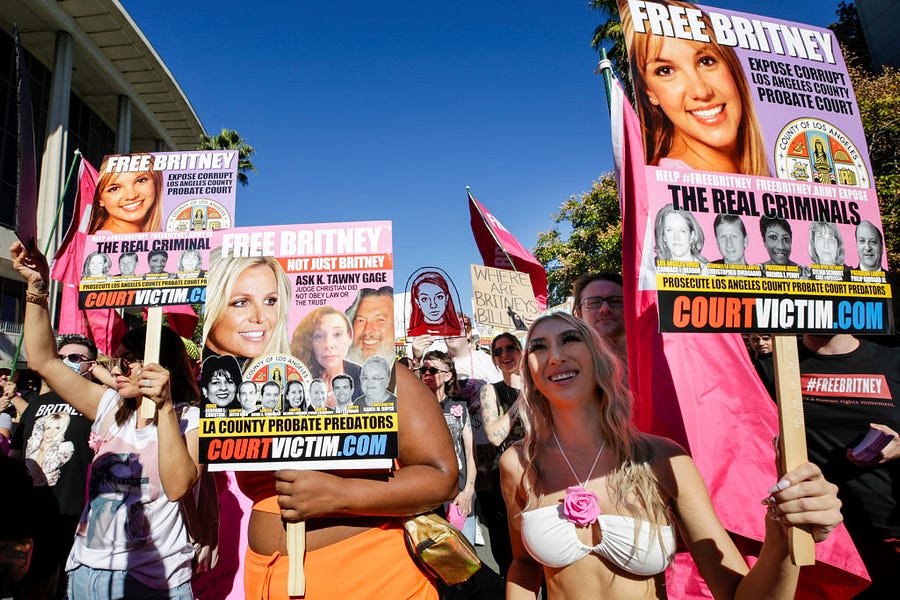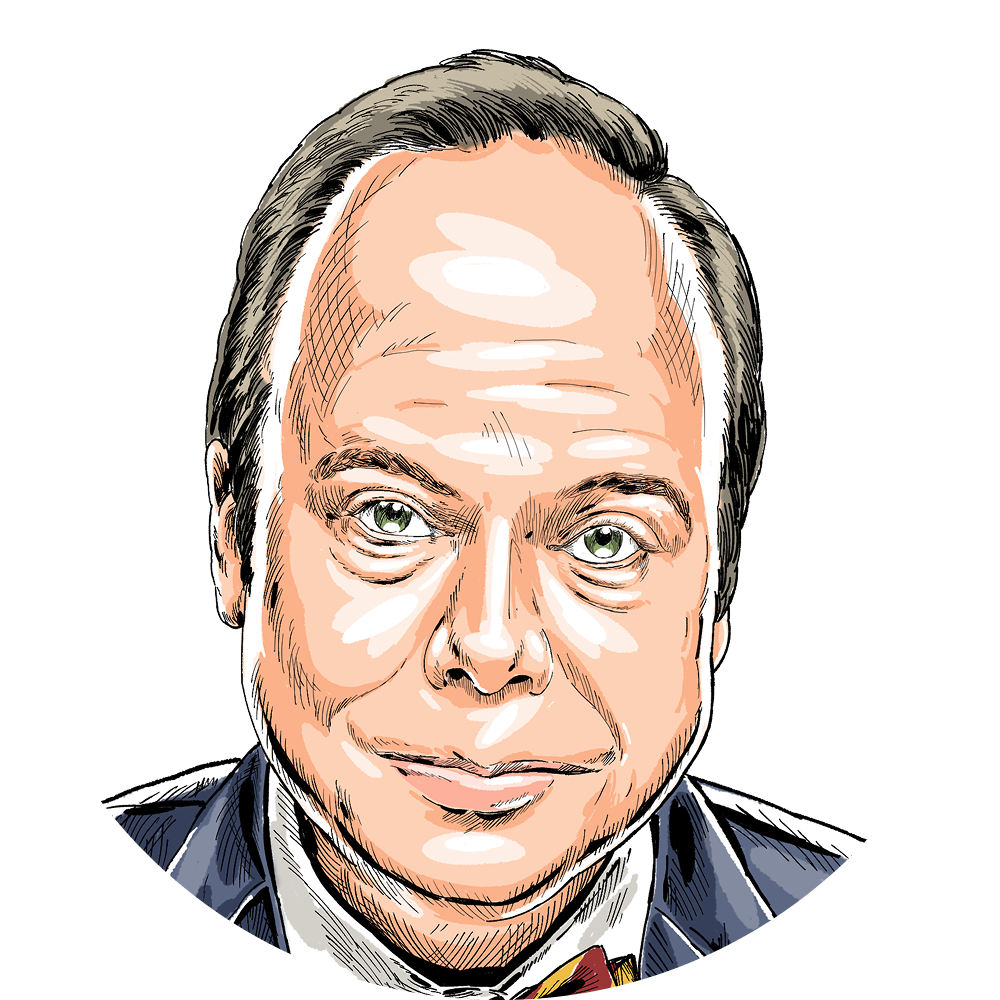The slanting Southern California sun on Friday afternoon demanded sunglasses—the big, black kind favored by local women. And to make matters worse, the television news crew had set up with their backs to the glare for a better shot. So, when members of the crowd assembled on Grand Avenue in front of the Stanley Mosk Courthouse got their turn on TV, they had to choose between eye strain and anonymity.
The woman who left Rhode Island at 6 a.m. to be there chose celebrity over comfort. She pulled off her big black frames and squinted into the sun blasting over the Dorothy Chandler Pavilion. The reporter wanted to know why she had flown 2,500 miles to mill around with a collection of her fellow ecstatic obsessives in a city street between two grim government buildings. “To celebrate what this movement—what we—have accomplished,” she said, brimming with emotion. “To be part of this moment. … Free Britney!!!”
The Rhode Islander said it was good to celebrate the end of the court-ordered conservatorship over the troubled, 40-year-old former child star and pop diva Britney Spears and her $60 million fortune. But another woman standing nearby wanted viewers to know that “the movement” must not stop there. This other woman, who made a sign to carry her message, said that she and her fellow pro-celebrity activists had to turn their energy to a larger cause and “end conservatorships for everyone.” No word on what families of seniors crippled by dementia and Alzheimer’s or younger adults with severe cognitive and psychological disabilities ought to do if they can’t afford a Hollywood power lawyer to oversee a trust and “safety net.”
The “movement” to end the conservatorship—known as a guardianship in most states—began soon after the star’s multipart breakdown that culminated in 2008 with her psychiatric commitment following a four-hour standoff with police when she locked herself in a bathroom with her then 1-year-old son. That was after she shaved her head in public and a court forbade a Rasputin of a manager from any contact with Spears. While you might think that this is a very particular kind of Mouseketeer-turned-sexpot-turned-Vegas-lounge-act-with-mental-problems case, the members of the movement are not alone in their desire to turn Spears’ saga into a, God help us, “larger conversation.” The American Civil Liberties Union, not one to pass up any free clicks, agrees. No word either for the victims of mass killings and domestic murders committed by those who should be under court-ordered mental health restrictions but who so often slip through the cracks.
Having achieved its short-term goal, #freebritney contemplates its legacy for the ages. If we want to be generous, we can say that maybe lifting their eyes to the mountains for a new goal reflects some knowledge among members of the movement that it didn’t really do anything to free Spears. It was Judge Brenda Penny, not they, who “freed” Spears. Penny didn’t even order a psychological evaluation, because the new arrangement will keep Sears wound in legal bubble wrap to protect her from herself. The money and fame that helped ruin her worked to Spears’ advantage this time . No doubt the support of her legions of fans was a great encouragement to the star. Like the crowd that cheers the home team on to victory, #freebritney perhaps helped sustain her in difficult times. But it did not do anything.
But many of the flibbertigibbets on Grand Avenue and online probably believe their public pressure changed the outcome of the case. I doubt Penny, who started working for the court 25 years ago as a probate attorney, crowdsourced her opinion. But if she did, she wouldn’t be the first L.A. County judge to succumb to the crowd madness of a celebrity case. Even in the unlikely event that Penny did knuckle under to the tank-top-clad #freebritney mob, why would anyone believe that the mob is right about further weakening America’s cruelly, dangerously insufficient mental health system? Maybe tips for Pinkberry toppings, but not the future of legal guardianship in America.
But then again, why would world leaders listen to people who followed a 12-foot-tall puppet through the streets of Glasgow, Scotland, to highlight “the intersectionality of migrant justice and the climate movement?” Or why would entertainment executives take the advice of a screaming throng carrying nonsense signs like “Gender is NOT a fact,” upset over, of all things, a comedian’s set? Why would anyone consider the opinions on public health policy of a mob that gets innocent people injured by trying to block the Golden Gate Bridge at rush hour to protest mandatory vaccinations? Why would members of Congress fawn over an angry mob that would end up sacking the Capitol in an effort to prevent lawmakers from doing their constitutional duty?
These protesters might think themselves more serious than the #freebritney folks, but it’s the same phenomenon. Communities built around obsessive interests online spill out into real life. Helping create a mob makes people feel powerful, and membership in a mob makes people even more fanatical. Those are intense incentives not just to act like lunatics, but to develop messianic ambitions. Today, Britney; tomorrow the world!
It would be swell if these folks could satisfy the natural, healthy desire for meaning and belonging by doing constructive—or at least benign—things where they live. Would that these maniacs were running eyeglass drives for the Lions Club or handing out hot chocolates with the Shriners at the holiday parade instead of hoisting giant puppets and screaming at strangers through bullhorns. But on the off chance that a wave of kindness and rationality does not soon sweep the Western world, the rest of us had better learn how to deal with the madness of crowds. Members of mobs don’t need individual courage, because membership in the collective gives them a sense of power, false accomplishment, and security. To defeat them, we will have to get better at being brave ourselves.







Please note that we at The Dispatch hold ourselves, our work, and our commenters to a higher standard than other places on the internet. We welcome comments that foster genuine debate or discussion—including comments critical of us or our work—but responses that include ad hominem attacks on fellow Dispatch members or are intended to stoke fear and anger may be moderated.
With your membership, you only have the ability to comment on The Morning Dispatch articles. Consider upgrading to join the conversation everywhere.